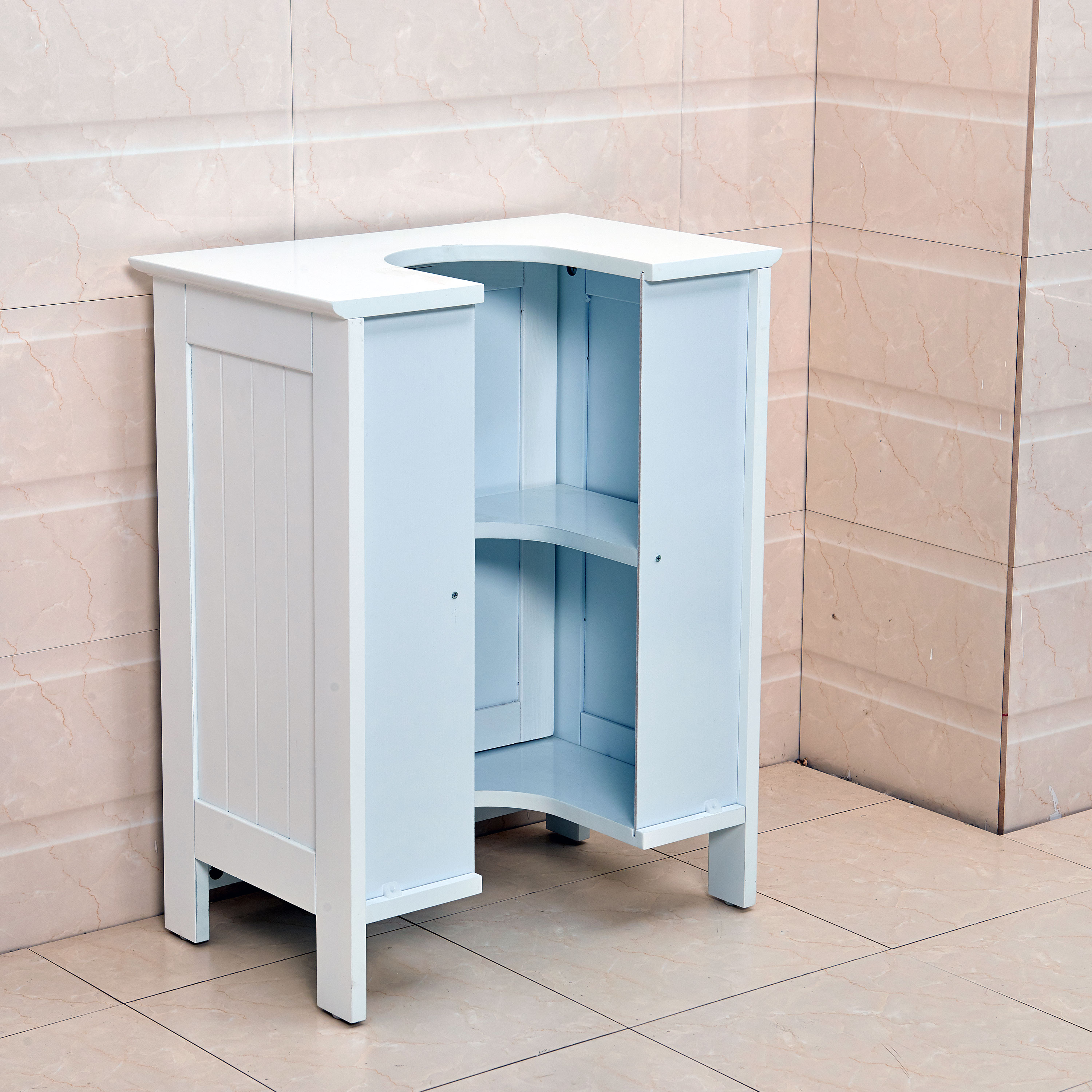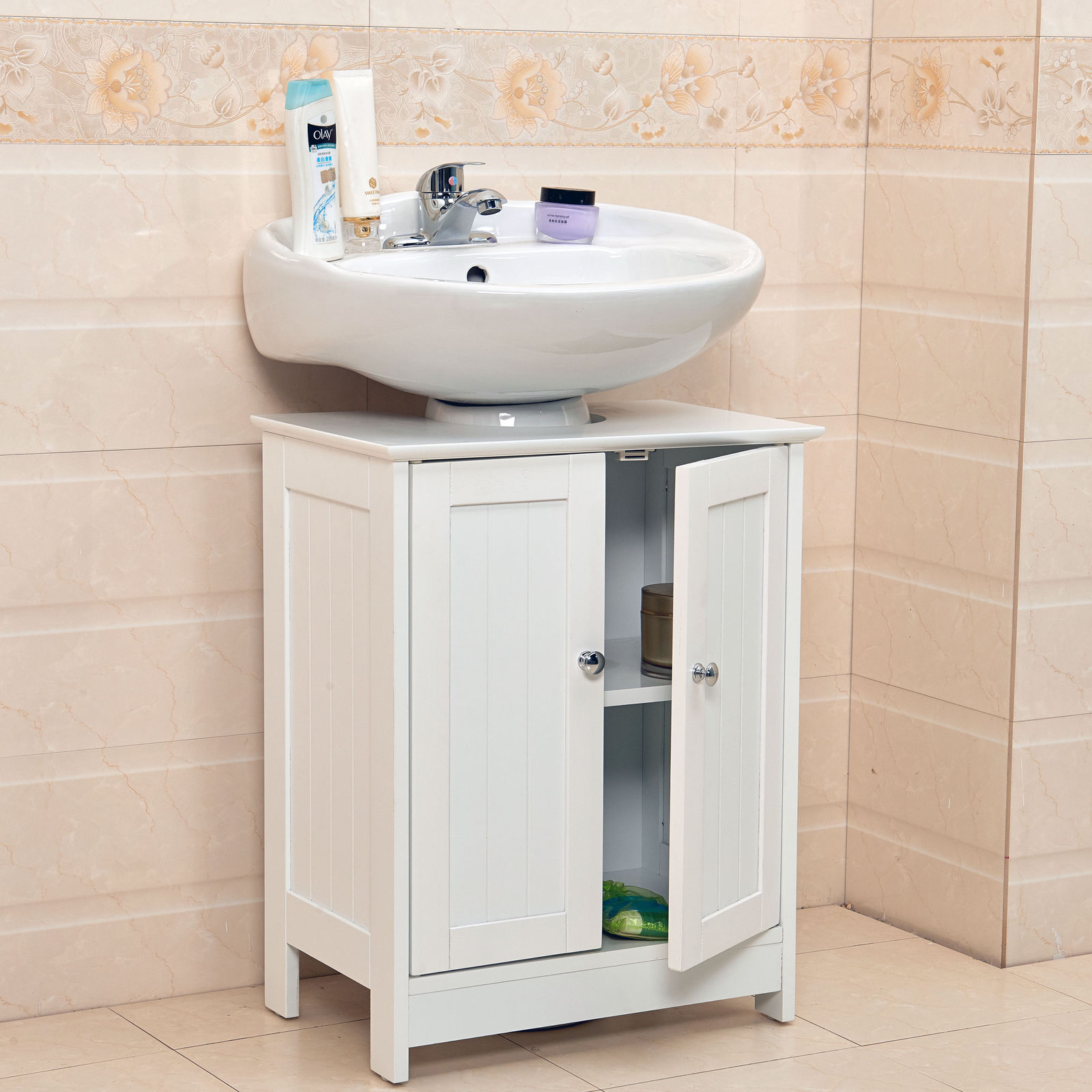Under Sink Basin Cabinet Design and Functionality

The under-sink basin cabinet is a crucial element in any bathroom, offering valuable storage space and enhancing the overall functionality of the room. Its design and functionality are key factors in maximizing its utility and creating a well-organized and efficient bathroom environment.
Types of Under-Sink Basin Cabinets, Under sink basin cabinet
Different types of under-sink basin cabinets are available, each offering distinct features and benefits. The choice of cabinet type depends on the size of the bathroom, the design aesthetic, and personal preferences.
- Single-Door Cabinets: These cabinets feature a single door that opens to reveal the storage space. They are compact and suitable for smaller bathrooms or when space is limited.
- Double-Door Cabinets: With two doors, these cabinets offer more storage space and easier access to items. They are ideal for larger bathrooms or those requiring ample storage.
- Drawers: Cabinets with drawers provide a more organized and efficient way to store bathroom essentials. They allow for easy access to items and prevent clutter.
- Combination Cabinets: These cabinets combine doors and drawers, offering a versatile storage solution. They provide both open shelves and drawers for organizing different types of items.
Design Elements for Functionality
The design of an under-sink basin cabinet plays a crucial role in its functionality and efficiency. Several design elements contribute to a well-designed cabinet.
- Adjustable Shelves: Adjustable shelves allow for customization of storage space to accommodate items of different sizes.
- Pull-Out Drawers: Pull-out drawers provide easy access to items stored in the back of the cabinet, eliminating the need to reach into cramped spaces.
- Deep Drawers: Deep drawers offer ample storage space for larger items such as towels, linens, or cleaning supplies.
- Soft-Close Hinges: Soft-close hinges prevent doors from slamming shut, reducing noise and wear and tear on the cabinet.
Storage Solutions for Organization
Proper storage solutions within the under-sink basin cabinet are essential for maintaining organization and maximizing space.
- Shelves: Shelves provide vertical storage, maximizing space and allowing for efficient use of the cabinet’s height.
- Drawers: Drawers offer a convenient and organized way to store smaller items, keeping them separate and easily accessible.
- Organizers: Organizers, such as baskets, bins, and trays, can be used to categorize and separate items within the cabinet, creating a more organized and efficient system.
Maximizing Space and Organization
Several practical tips can help maximize space and organization within the under-sink basin cabinet.
- Utilize Vertical Space: Make the most of vertical space by using shelves, stackable containers, and hanging organizers.
- Use Clear Containers: Clear containers allow for easy visibility of stored items, making it easier to find what you need.
- Group Similar Items: Group similar items together, such as toiletries, cleaning supplies, or medications, for easy access and organization.
- Regularly Declutter: Regularly declutter the cabinet, removing unused or expired items to free up space.
Visual Guide to Under-Sink Basin Cabinet Designs
Single-Door Cabinet: This type of cabinet features a single door and is suitable for smaller bathrooms. It typically has adjustable shelves for storing items of different sizes.
Double-Door Cabinet: With two doors, this cabinet offers more storage space and easier access to items. It can include shelves, drawers, or a combination of both.
Cabinet with Drawers: Cabinets with drawers provide a more organized and efficient way to store bathroom essentials. They allow for easy access to items and prevent clutter.
Combination Cabinet: These cabinets combine doors and drawers, offering a versatile storage solution. They provide both open shelves and drawers for organizing different types of items.
Choosing the Right Under Sink Basin Cabinet

Selecting the right under-sink basin cabinet is crucial for maximizing functionality and aesthetics in your kitchen. It’s not just about hiding pipes and cleaning supplies; it’s about creating a space that’s both practical and visually appealing.
Factors to Consider When Choosing an Under-Sink Basin Cabinet
Before you begin shopping, consider these key factors:
- Size: The most important factor is the size. Measure the space under your sink carefully, taking into account the sink’s dimensions and any existing plumbing or pipes. Leave some wiggle room for easy access and maneuverability.
- Material: Cabinet materials range from durable wood to budget-friendly plastic. Each material has its own advantages and disadvantages, impacting both price and longevity.
- Style: Your under-sink cabinet should complement your kitchen’s overall design. Consider the style of your cabinets, countertops, and other fixtures to create a cohesive look.
- Budget: Set a realistic budget before you start shopping. Cabinet prices vary significantly depending on materials, features, and brand.
Comparing Under-Sink Basin Cabinet Materials
The choice of material can significantly impact your cabinet’s durability, aesthetics, and price. Here’s a comparison of popular materials:
| Material | Advantages | Disadvantages |
|---|---|---|
| Wood | Durable, natural beauty, can be stained or painted | More expensive, susceptible to moisture damage, requires regular maintenance |
| Metal | Durable, resistant to moisture, easy to clean | Can be noisy, may dent or scratch easily, may not blend well with all kitchen styles |
| Plastic | Affordable, lightweight, easy to clean | Less durable, may not be as aesthetically pleasing, may not be suitable for heavy items |
Measuring the Space Available for the Cabinet
Accurate measurements are crucial for choosing the right size cabinet. Here’s a step-by-step guide:
- Measure the width and depth of the space under your sink. Make sure to measure the widest and deepest points, taking into account any protruding pipes or fixtures.
- Consider the height of the space. Most under-sink cabinets come in standard heights, but you might need a custom cabinet if your space has unusual dimensions.
- Account for door clearance. Ensure there’s enough space for the cabinet doors to open and close without hitting any obstructions.
- Leave some wiggle room. It’s best to choose a cabinet that’s slightly smaller than the available space to allow for easy access and maneuverability.
Matching Cabinet Style to Kitchen Design
The under-sink cabinet should complement the overall design aesthetic of your kitchen. Here are some tips:
- Consider the style of your cabinets. If you have traditional cabinets, choose a cabinet with a similar style. If you have modern cabinets, choose a cabinet with clean lines and a minimalist design.
- Match the color or finish. Choose a cabinet that matches the color or finish of your existing cabinets or countertops.
- Think about the overall theme. If your kitchen has a farmhouse theme, choose a cabinet with rustic elements. If your kitchen has a contemporary theme, choose a cabinet with sleek, modern lines.
Comparing Under-Sink Basin Cabinet Models
Here’s a table comparing different under-sink basin cabinet models based on features, price, and user reviews:
| Model | Features | Price | User Reviews |
|---|---|---|---|
| [Model Name 1] | [Features] | [Price] | [User Reviews] |
| [Model Name 2] | [Features] | [Price] | [User Reviews] |
| [Model Name 3] | [Features] | [Price] | [User Reviews] |
Installing and Maintaining an Under Sink Basin Cabinet

Installing an under-sink basin cabinet is a relatively straightforward process that can be completed with the right tools and a bit of patience. This section will guide you through the steps involved in installing and maintaining your under-sink basin cabinet, ensuring a long and functional life for your bathroom fixture.
Installing an Under Sink Basin Cabinet
The installation process involves assembling the cabinet components, attaching it to the sink, and securing it to the wall. To ensure proper installation and avoid common mistakes, follow these steps:
- Assemble the cabinet components: Begin by assembling the cabinet according to the manufacturer’s instructions. This typically involves connecting the sides, back, and bottom panels, and attaching the doors or drawers. Use appropriate screws or fasteners and ensure all components are securely connected.
- Attach the cabinet to the sink: Once assembled, the cabinet needs to be attached to the sink. This is usually done using a specialized bracket or clip system that is included with the cabinet. Refer to the manufacturer’s instructions for specific details on attaching the cabinet to your sink.
- Secure the cabinet to the wall: Finally, secure the cabinet to the wall using appropriate screws or brackets. Ensure that the wall is strong enough to support the weight of the cabinet and its contents. Locate studs in the wall for maximum support, and use appropriate fasteners to ensure a secure installation.
Essential Tools and Materials
Here are the essential tools and materials required for installing an under-sink basin cabinet:
- Screwdriver: For assembling the cabinet and attaching it to the sink and wall.
- Drill: To create pilot holes for screws and to install brackets.
- Level: To ensure the cabinet is installed level and plumb.
- Measuring tape: To accurately measure the dimensions of the cabinet and the space where it will be installed.
- Pencil: To mark the locations for screws and brackets.
- Safety glasses: To protect your eyes from debris during drilling and installation.
- Screws and brackets: Depending on the cabinet and wall type, you may need screws and brackets specific to the installation.
Maintaining an Under Sink Basin Cabinet
Regular cleaning and maintenance are essential to preserve the appearance and functionality of your under-sink basin cabinet.
“A clean and well-maintained under-sink basin cabinet will last longer and look better for years to come.”
Routine Maintenance Checklist
Here is a checklist of routine maintenance tasks for your under-sink basin cabinet:
- Clean the cabinet regularly: Wipe down the interior and exterior of the cabinet with a damp cloth to remove dust, dirt, and spills. Use a mild cleaning solution if necessary.
- Check for leaks: Inspect the cabinet and plumbing connections for any signs of leaks. Address any leaks promptly to prevent water damage.
- Tighten screws and brackets: Periodically check the screws and brackets that secure the cabinet to the sink and wall. Tighten any loose screws to ensure the cabinet remains stable.
- Inspect the doors and drawers: Ensure that the doors and drawers open and close smoothly. Lubricate any hinges or slides that are becoming stiff.
Under sink basin cabinet – Just as an under-sink basin cabinet provides hidden storage, a well-placed upholstered bedroom bench seat can offer a comforting spot to rest while adding an elegant touch to your decor. Both these seemingly simple items can elevate the functionality and beauty of a space, reminding us that even the smallest details can contribute to a greater sense of harmony and purpose.
Just as the under sink basin cabinet holds the unseen, yet essential, plumbing of our kitchen, so too does the heart of our home hold the unseen, yet essential, spirit of our lives. Consider the elegance of white kitchen cabinets with wood counters , a timeless combination that speaks to both practicality and beauty.
Like these cabinets, the under sink basin cabinet serves a quiet purpose, providing a space for the unseen elements that keep our lives flowing smoothly.